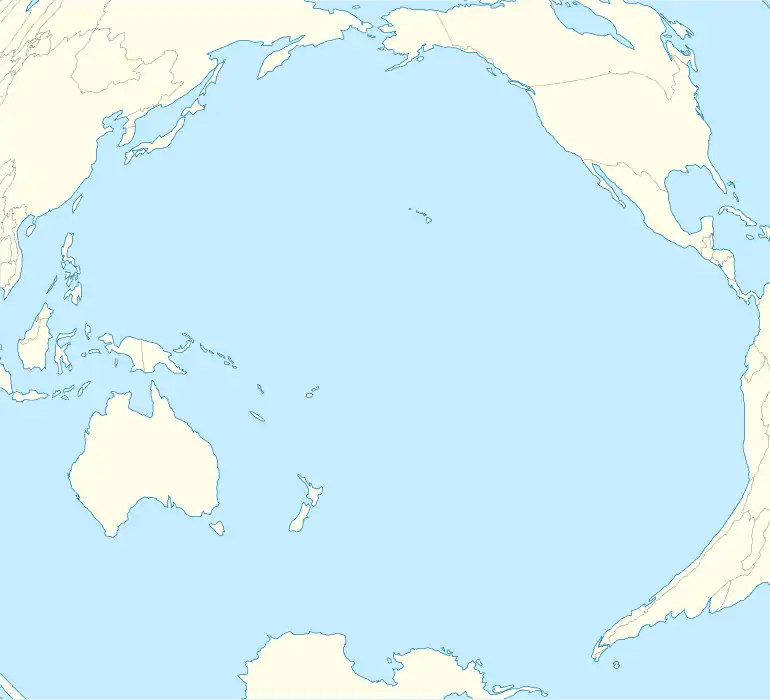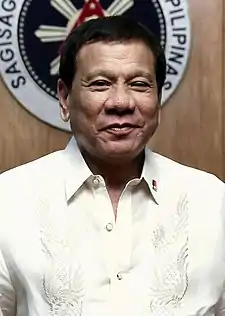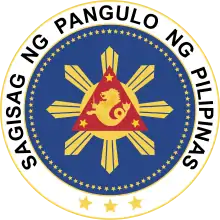Canada–Philippines waste dispute
The Canada–Philippines waste dispute was an international row over mislabeled Canadian garbage shipped to Manila by a recycling company. The 103 shipping containers that left from Vancouver in 2013–14 were labeled as recyclable plastics; they instead contained household waste. The intricacies of international treaties, the private company involved, and red tape complicated the situation through 2019 when the Philippine president, Rodrigo Duterte, began threatening Canada with ultimata. On 30 May 2019, 69 containers of Canadian trash began their trip home.

Garbage
In 2013 and 2014, 103 shipping containers were transported from Vancouver to Manila[1] by Chronic Plastics Inc.[2] Though declared to contain recyclable plastic, the Bureau of Customs found instead "household trash, plastic bottles and bags, newspapers, and used adult diapers".[3]
Chronic Plastics has been accused of violating the Basel Convention (on the Control of Transboundary Movements of Hazardous Wastes and Their Disposal); the Philippines and Canada are both signatories. While the treaty stipulates that "the exporting country must take back the waste materials if the receiving country refuses to accept them", Canada refused on the grounds that the garbage was municipal solid waste, not hazardous waste.[4] The Philippine Department of Environment and Natural Resources' Hazardous Waste Management Section Chief, Geri Geronimo Sañez, confirmed this saying, "It's a blue bin waste. [sic] That's paper, dry plastic generated from the kitchen. I have not seen any syringe, any diaper. It's not hazardous, but it's waste still". By November 2017, at least 26 of the containers' trash had been buried at a landfill in Capas, Tarlac.[5]
Repatriation
In 2016, a Philippine court ruled that the garbage should return to Canada.[3] That same year, Canadian environmental laws were changed to require companies such as Chronic Plastics to retrieve their trash.[6] At the 2017 summit for the Association of Southeast Asian Nations, Canadian Prime Minister Justin Trudeau explained that Canadian laws and regulations had prohibited his nation from accepting the garbage, but that workarounds were in place, though the two nations had not yet settled on financial responsibilities.[5] As of 13 November 2018, storing the Canadian waste had cost approximately 36 million Philippine pesos (714,286 United States dollars).[4]
In an analysis of the situation in January 2019, Antonio La Viña said that there was nothing for the Philippines to do but wait on Canadian retrieval of the trash.[4] About three months later, in the wake of the 2019 Luzon earthquake, Filipino President Rodrigo Duterte lashed out at Canada over the garbage remaining in Manila. After accusing Canada of denigrating Filipinos, Duterte proclaimed that if the trash was not removed by Canada within a week (by 30 April 2019), the Philippines would declare war on Canada.[2] In response to Duterte's threat, the Canadian ambassador to the Philippines said, "I won't comment on the specific words of the president or his tone, but I will say this: Our prime minister committed and has recommitted to resolving this issue, including taking the waste back to Canada."[3]
A week after his deadline was missed, Duterte set a new one of 15 May, with his secretary of foreign affairs—Teodoro Locsin Jr.—saying,[6] "The President expects the garbage to be seaborne by May 15. That expectation will be met or else…"[7] That same day, Global Affairs Canada announced that they had made an offer to retrieve the garbage and were working closely with the government of the Philippines to work out the details.[8] Bolloré Logistics Canada was awarded the Canadian government's contract to ship the waste out of the Philippines.[9]
At the Subic Special Economic and Freeport Zone[10] on 30 May 2019, 69 shipping containers of Canadian trash were loaded onto the cargo ship M/V Bavaria for transport to Canada[9][11] at a cost of US$840,000.[12] After being transferred to the Anna Maersk while in Taiwan, the trash was still on schedule[9] to reach Canada by the end of June 2019, after which—according to Environment and Climate Change Canada—it would end up at a Vancouver waste-to-energy plant.[12]
On 4 June, with the refuse matter considered settled, Philippine Executive Secretary Salvador Medialdea lifted Duterte's five-day bans on traveling to Canada and doing business with Canadian officials. By 6 June though, the Philippine ambassador to Canada had not yet returned.[13] Finally, on 29 June 2019, 69 containers of Chronic Plastics' wayward trash[14] arrived at the Roberts Bank Superport in Delta, British Columbia.[15]
References
- Shore, Randy (24 April 2019). "Philippines fiasco: Doctored paperwork obscures origin of garbage shipped to Manila". Vancouver Sun. ISSN 0832-1299. Archived from the original on 26 April 2019. Retrieved 29 April 2019.
Other than being shipped from Vancouver, little is known about where the material really came from.
- Merez, Arianne (23 April 2019). "Duterte threatens 'war' vs Canada over trash shipment". Manila: ABS-CBN Corporation. Archived from the original on 23 April 2019. Retrieved 24 April 2019.
- Chappell, Bill (24 April 2019). "Philippines' Duterte Talks Trash (Literally) To Canada, Threatening War Over Garbage". NPR. Archived from the original on 24 April 2019. Retrieved 24 April 2019.
- Quintos, Patrick (16 January 2019). "Why Canada garbage still in PH after 5 years while Korean trash is going back". Manila: ABS-CBN Corporation. Archived from the original on 30 March 2019. Retrieved 24 April 2019.
'Canada refused to take responsibility over trash'
- Domingo, Katrina (14 November 2017). "Trudeau: Canada working to resolve 'irritant' trash issue with PH". Manila: ABS-CBN Corporation. Archived from the original on 22 January 2019. Retrieved 24 April 2019.
- Gutierrez, Jason (8 May 2019). "Philippines Sets Deadline for Canada to Take Back Trash". The New York Times. Manila. ISSN 1553-8095. OCLC 1645522. Archived from the original on 11 May 2019. Retrieved 14 May 2019.
- Locsin Jr., Teodoro [@teddyboylocsin] (7 May 2019). "The President expects the garbage to be seaborne by May 15. That expectation will be met or else…" (Tweet). Archived from the original on 13 May 2019. Retrieved 14 May 2019 – via Twitter.
- Choi, Tyler (7 May 2019). Ljunggren, David (ed.). "Canada will accept garbage containers wrongly sent to Philippines, says Manila". Toronto. Reuters. Archived from the original on 9 May 2019. Retrieved 14 May 2019.
- Smith, Marie-Danielle (18 June 2019). "Garbage from Philippines on its way to Canada aboard a different ship, government says". National Post. Ottawa. ISSN 1486-8008.
After a series of stops along the shipping route, the ship docked in Taiwan where the containers full of garbage were offloaded and transferred to a larger ship
- Lopez, Ron (1 June 2019). "Philippines ships dumped trash back to Canada". The Jakarta Post. Southeast Asia. Agence France-Presse. ISSN 0215-3432. Archived from the original on 17 June 2019. Retrieved 18 June 2019.
- Cabana, Ysh (28 June 2019). "Garbage shipped back to Canada". The Philippine Reporter. Archived from the original on 13 June 2020. Retrieved 13 June 2020.
- Kennedy, Merrit (31 May 2019). "'Sordid Chapter' Ends As Philippines Sends Back Canada's Trash". NPR. Archived from the original on 16 June 2019. Retrieved 18 June 2019.
- "Philippines normalizing Canada relations after garbage dispute". Ottawa: Global News. The Canadian Press. 6 June 2019. Archived from the original on 20 July 2019. Retrieved 26 July 2019.
- "Canada takes garbage back from Philippines, ending long dispute". Vancouver: CNA. 29 June 2019. Archived from the original on 26 July 2019. Retrieved 27 July 2019.
- "Canada waste returns home after Philippines' war threat". Deutsche Welle. 29 June 2019. Archived from the original on 26 July 2019. Retrieved 27 July 2019.
More than 60 containers full of garbage have returned to the western shores of Canada after being stranded for years in the Philippines. The matter had sparked a diplomatic row and prompted threats of an armed conflict.

